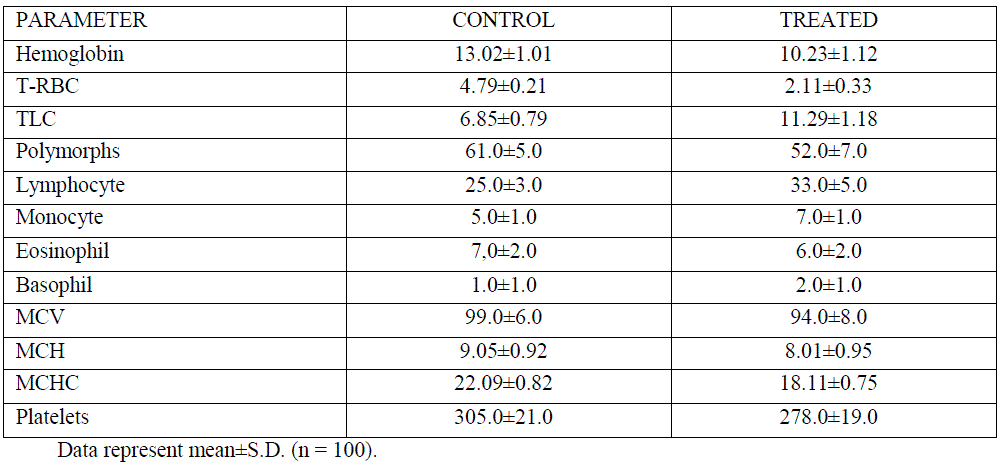ISSN ONLINE(2319-8753)PRINT(2347-6710)
ISSN ONLINE(2319-8753)PRINT(2347-6710)
Ahinsa Tripathi1, F.W. Bansode2 and R.K. Singh1,
|
| Related article at Pubmed, Scholar Google |
Visit for more related articles at International Journal of Innovative Research in Science, Engineering and Technology
India is a second largest rice growing countries in the world. A large number of unskilled laborers are employed for paddy processing. In rice mills, most of the workers have shown adverse health effects associated with occupational exposure to rice husk dust (WHO, 1968). Present study was conducted to determine the hematological disorders in rice mill workers in rural/urban areas of Uttar Pradesh. Total numbers of 100 blood samples were collected from rural and urban area from rice mill workers of Lucknow district. Majority of hematological test parameters showed reduced levels in rice mill workers. This study would be helpful in preventing longstanding harmful effects of such exposures. It is also useful for preventing environmental risks. It is concluded that rice husk dust causes deterioration of hematological parameters in subjects working at rice mills. The findings of this study recognized the role of rice husk dust for a longer duration in decline of hematological parameters as per tests conducted among rice mills workers. Significant hematological disorders were observed in rice mill workers
Keywords |
| Blood, Hematology, Rice husk. |
INTRODUCTION |
| Rice is the staple food for 65% of the population in India. It is the largest consumed calorie source among the food grains. India is the second largest producer of rice in the world next to China. In India paddy occupies the first place both in area and production. West Bengal is the leading producer of paddy in the country. It accounts for 16.39% of the total production, and the other leading states are Uttar Pradesh (13.38%), Andhra Pradesh (12.24%), Punjab (9.47%), Orissa (7.68%) and Tamil Nadu (7.38%); the remaining states account for 33.45% of the production. India is also one of the leading exporters of rice in the world market. There is significant proportion of the population working in this sector. Rice cultivation is done in the irrigated fields . The crop is harvested , dried and milled. A large amount of dust is generated , especially during the milling activities. Rice mill workers are potentially exposed to organic and inorganic dust and rice husk that may have adverse effect on hematological parameters. Several reports have suggested that unprotected dust exposures in agricultural settings may lead to hematological disorders .There have been many reports on health effects of rice husk exposures. Rice husk has a long history association with disease , and its adverse effect on various organ such as eyes , nose , skin , lung and the hematological parameters have been described .rice husk is known to have a high silica content .This study was thus carried out in Lucknow District to determine whether there were adverse health effect associated with occupational exposure to rice husk dust. We have collected 100 blood samples from rice mill workers in and around city of Lucknow. |
II. MATERIALS AND METHODS |
| The study population consisted of all workers employed in rice mill in the Lucknow District. Altogether there were 129 workers employed at the time of the study period , only 100 workers were selected for this study. The controls were of the same sex ethnic group and from a similar agriculture work background of rice husk dust exposure. Each subject and control was interviewed by a physician using a standard questionnaire based on hematological symptoms. The questionnaire were pertaining the past medical history , personal details and smoking .Blood samples were also collected by a finger prick using a triangular surgical needle . Blood samples were collected in EDTA vial mixed gently and analyzed it using the MS-9 fully automatic analyzer. For the study of hematological parameters. Statistical analysis All the results were expressed as mean ± standard deviation (S.D.). Data was analyzed using one-way ANOVA (Graph Pad Prism Software) at 95% confidence interval. |
III. RESULTS |
| vThere was no significant differences between the mean age of the subjects and the controls. The smoking habits of the workers and controls are compared but there was no significant difference. 100 rice mill workers were assessed. In our study significant changes in hematological parameters were observed .Greater proportion of anemia, leukocytosis eosinophilia , pterygium and conjunctivitis was observed. significant changes in anemia and in leukocytosis were observed. |
 |
IV. DISCUSSION |
| The clinical and hematological findings suggest that the harmful effect linked with rice husk dust. There is significant greator proportion of anemia and leukocytosis were observed. Rice husk dust could cause kerato-conjunctival irritation, corneal scars, chronic conjuctival inflammation , pterygium formation and pruritus . In addition , allergic inflammatory reaction of pulmonary tissues were suggested to be related with rice husk exposures. According to this study ,it seems that there is a impairment of the hematological parameters for the rice mill workers and it indicates further extensive epidemiological and pathological studies health and safety of the rice mill workers. This study would be helpful in preventing longstanding harmful effects of such exposures of rice husk. |
V. CONCLUSION |
| In our study significant abnormalities were observed in the hematological parameters of rice mill workers of district Lucknow Uttar Pradesh. |